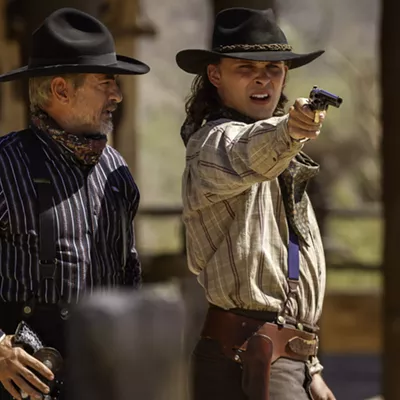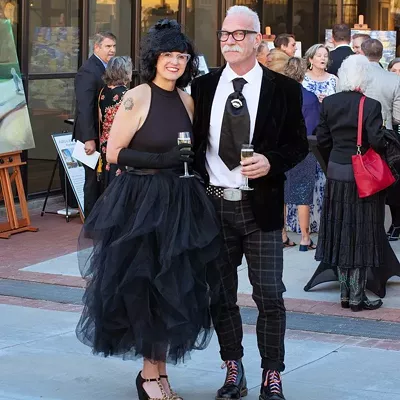The faces bring it home, those wrenchingly crystalline expressions of circumstance, sometimes grim, sometimes defiant, but always profoundly human. Their images, and the trappings that surround them, unfurl the narrative of two neighboring countries that time and cynical politics have pulled ever farther apart.
This distance—more emotional than geographic—lies at the heart of A World Separated by Borders, an exhibit of riveting black and white photography by Alejandra Platt-Torres, now showing at the Arizona State Museum.
Platt-Torres herself is a bi-national nomad, shuttling between homes in Tucson and Hermosillo, Sonora. As such, these works reveal her precise understanding of the U.S.-Mexico borderland and the fierce drive of immigrants to span both worlds—even while they expose the border itself as a brutally spurious construct.
Though Platt-Torres presumably makes that passage by car rather than on foot, her work reveals a deep sensitivity to the illegal immigrants' plight. "I am a migrant," she writes in text accompanying the exhibit. "I am the third generation in a family of migrants ... Since I was a child, I've been crossing the border with my family, regularly coming back and forth to visit relatives and to go shopping. There is no border in my world."
But Washington, D.C., policy makers and the burgeoning border-security industrial complex have fashioned their border into a parallel universe—one that bears little resemblance to on-the-ground reality in Southern Arizona.
That trend only heightened in the aftermath of Sept. 11, when Platt-Torres began compiling the pieces for this exhibit. The United States had gone into lock down, and intensified border security was creating a deadly gauntlet for migrants. But in fact, these killing fields stretch back to the mid-1990s, when the U.S. Border Patrol first unveiled Operation Hold the Line in El Paso, Operation Gatekeeper in San Diego, and Arizona's own Operation Safeguard.
These various Border Patrol strategies shared one key element: spinning a thick enforcement web around towns like Nogales and Douglas, thereby forcing crossers out into the desert where they were more easily apprehended—and much more likely to die.
Hike into the borderland back country and you'll discover a place far beyond the confines of civilization. It is a terrain marked by ghosts, and their trappings are everywhere; sunlight glances off water bottles, candy wrappers, tennis shoes, rosaries, a tiny picture of the Virgen de Guadalupe in yellowing, cracked plastic.
Such things are hastily abandoned in the headlong passage between life and death, the fate of their owners unknown.
But the nature of their passage is not so faceless. And capturing that essence is the genius of this work by Platt-Torres. While the theme has been explored in photography many times before, the exhibit is hardly derivative. Instead, she reveals the border region as cruel and beautiful, a paradox perfectly evoked by an enormous triptych of the Sonoran Desert greeting visitors as they enter.
To me, her imagery evokes one thought, and that is desire. For it's desire that truly animates the Southwest border—a primal hunger compelling people to risk the lives they have for the better lives they imagine ... if they can just reach the other side of that perilous, almost mystical frontier.
In "Bravo-Castro," we see a woman by that name (she still wears a U.S. detention ID bracelet) as she despondently holds a telephone to one ear. We glimpse another young woman in custody, or at least her wrist, which carries a band that simply says "Juvenile."
These black-and-white images also portray the agents of that frustration—helicopters whirling above, the border fence snaking among the Nogales hills—and the immediate chaos of surrender, the discarded clothing blown into the trees or rotting in the dirt.
And then there's the dead, the "John Doe" in a body bag at the Pima County morgue. Not surprisingly, this mercurial world also stokes rampant superstition, such as in "Leonardo," picturing a man with a pendant of Santa Muerte, or the "Saint of Death," dangling around his neck.
But for all the pain and rage of frustrated desire, there is also kindness and love. These we also see, as Platt-Torres slyly captures their subtle expressions in images such as in "Panchito," depicting a man who was deported after many years in the United States; he now helps other returnees in Nogales, Sonora. Or the beaming pilgrim who has a tattoo of his young daughter on his arm, an image that travels with him back and forth across the line.
In the end, this exhibit and its three sections—from leaving Mexico to a furtive life in America—fully reinforce notions of the international line as a crime and an artifice.
On our side, of course, Americans might smugly consider themselves far removed from the borderland struggle. But spend enough time with this beautifully melancholic exhibit, and you're likely to glimpse just a hint of yourself. Surely, that's the highest compliment bestowed on any work of art.







